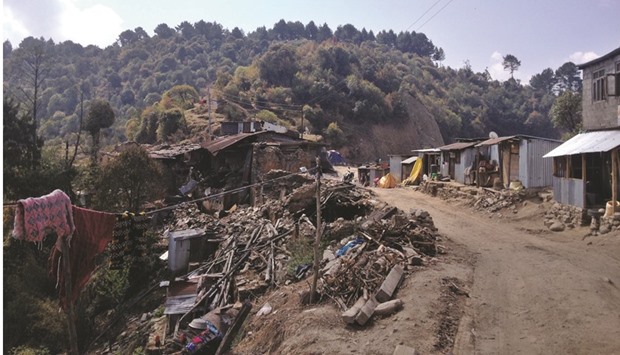Haribansa Thami gestures towards the ruined house where he used to live with his family on a mountainside in Nepal’s Dolakha district
“I’m angry,” he said. “The people are angry. We voted for them, and we expected them to do something for us. But it is like the Nepal government is still running from the
earthquake.”
Thami and his neighbours are not the only people who are angry. On 25 April, it will be one year since the first of two major earthquakes hit the country, killing nearly 9,000 people, damaging or destroying almost 1mn homes and disrupting 5.2mn lives.
Emergency relief eventually reached most people thanks to local and international NGOs and the government. But the next stage – rebuilding – has barely begun, despite $4.1bn pledged at an international donor conference last June for that very purpose.
Now there are fears that the full amount of money may never materialise due to delays caused by the government, which instead focused on pushing through a new and controversial constitution in the months after the disaster.
“Because of the crisis, the country couldn’t move from recovery to reconstruction,” said Plan International’s Nepal country director, Mattias Bryneson. “The slower it is, the less money they will get. If there is no project where the $4bn can be put in, the donors will not stay.”
Hundreds of thousands of people are now bracing themselves for their second monsoon season in temporary shelters. The government recently admitted it won’t be able to finish – or even begin – the construction of permanent housing in many districts before the
rains hit.
Renu Sharma, who runs the Women’s Foundation Nepal, was blunt: “This was a natural disaster, but the humanitarian disaster is far worse.”
The National Reconstruction Authority finally emerged from months of political squabbling as a functional body in December. It began work on January 16.
The NRA has finally dipped into the $4.1bn pool of pledges. Of that, only around $1bn is committed. The rest of the money is, at least theoretically, sitting in the bank accounts of the donors that have not yet signed agreements to get it to Nepal. Of the committed funds, only around $615mn is actually available in Nepal, from donors like the World Bank, the Asian Development Bank and the Japan International Cooperation Agency, according to NRA joint
secretary Ram Thapaliya.
“Donors are sceptical about the feasibility of implementing their money,” warned one high-level donor agency official who was not authorised to speak to media. He pointed out that India and China have pledged $2bn between them, which has not yet been
accessed.
Thapaliya said he “hopes” the money will remain available, but “time is moving on”. He promised housing reconstruction will take three years; local officials fear it could be more
like 20.
For Thami, it is too long to wait. As has been the case since the earthquake, he will have to depend on help from NGOs, and ultimately trust the only person he can rely on: himself.
“This is a temporary shelter for one to two years. We made it because we expected the money, but (the government) are late in everything,” he said. “But I am hopeful I can rebuild my life. I’m young, I can do things for my
future.”

A year after the quake, rubble still litters Dolakha district and much of the country.


